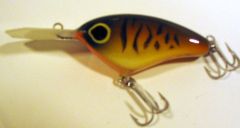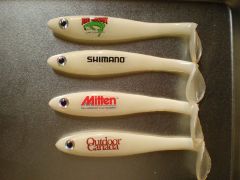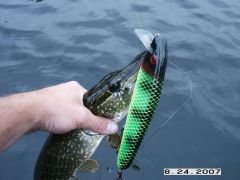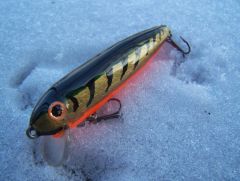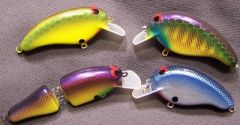-
Posts
1,854 -
Joined
-
Last visited
-
Days Won
9
Content Type
Profiles
Articles
TU Classifieds
Glossary
Website Links
Forums
Gallery
Store
Everything posted by fatfingers
-
By firmly securing the netting, you can acquire a great deal of control of where the paint goes and you can even apply the use of stencils to create isolated areas of scales.
-
If you try to put "scales" on your bait using netting, you'll find it to be VERY easy to do. Just make sure that when you drape the netting over the bait, you hold it tightly against the body. Here's how I do my "scaling." ....... 1. Place the bait in a vise by clamping the tail eyescrew. It allows the bait to be suspended by the tail in a horizontal position. 2. Drape the "veil" material or "netting" as I call it, over the bait and let it hang down beneath the bait. Position it carefully. Pay attention to how the holes in the netting line up against the sides and top of the bait. 3. Secure the netting tightly against the body by hanging clamps onto the netting. I pinch both loose pieces together beneath the bait and use refrigerator clamps to clamp them together. (Refrigerator clamps are those magnetic clamps like you see on a clipboard, but they're designed to hold notes, pictures, etc, on your frig.) 4. Spray from the tail forward. Mist the paint on. You can always add more, but you can't take it off after you put it on. Add layers of color till your happy with the results. Then, for Pete's sake stop. Don't be tempted to add more here or there (like I usually am). Less is more, usually, if you know what I mean. If you're using black, as I almost always do, know that black is a powerful color on a bait and a little goes a long way to adding depth to the shoulders/top of the bait, so go easy with it. 5. Give it a minute or two and then remove the clamps. Finally carefully remove the netting, starting from the nose and working slowly toward the tail. I always love that part of the painting. Don't ask me why, but I do. http://i8.photobucket.com/albums/a21/vc1111/Muskyshots043.jpg http://i8.photobucket.com/albums/a21/vc1111/Muskyshots044.jpg With the above method you can also flip the bait over (belly up) , place it in the vice, and put smaller finer netting on to get smaller finer scales on the belly area of the bait.
-
The use of stencils and the ability to control how much paint you apply are two important keys to airbrushing anything. By default siphon feeders require a bit more air pressure because the paint must be pulled upward into the brush (as opposed to allowing it to simply fall into the brush by way of gravity) and even pure water would require more pressure to pull upward. Of course the viscosity of paint increases the need for additional air pressure for the siphoning action to a degree which increases as the viscosity increases. Without a big debate about physics, that is the only difference aside from the different ways the two types of brushes must cleaned between colors (and the cleaning difference is negligible). But...because additional pressure is required to siphon the paint upward, you would probably find that you need more pressure to operate a siphon feed brush as opposed to a gravity feed brush (all other variables being equal). Additional pressure generally equals more paint being applied at one time. The main advantage of the gravity feed is the ability to shoot with lower pressure, which translates into the ability to shoot finer details with less overspray. Controlling the air pressure by way of finer adjustments to the air brush and utilizing smaller needles with less air pressure is a lot of way you're paying for in a top of the line airbrush. With all that said, you can still do great work with either brush; its a matter of practice...but greater control over the rate of paint being applied is a nice variable to have at your fingertips.
-
I'm sorry for my above post. I misread the question. I thought you were asking how to get foil on the bait without overlapping and wrinkles.
-
I know of no way to do it with waterbase colors, but enamels have great chromes available.
-

Quick Tips...take em all, but leave one of your own!
fatfingers replied to fatfingers's topic in Hard Baits
We need to revive this thread. Would it possible to make this a sticky????? -
To apply the mesh without overlap, do one side at a time. Apply the mesh to the first side and let the mesh go ahead and over lap a little. Then use an Xacto knife and cut a line straight down the back of the bait (along the entire length of the top or "back" of the bait). Lift the excess mess off. Then cut a straight line down the belly and pull the excess off. In other words, cut along the belly in the center of the bait, from the nose to the tail. Now you should have mesh over the side, and halfway across the back line and the belly line. Next, put the mesh on the other side and let it overlap a little. Take your Xacto knife and carefully make a cut along the same line on the back. Remove the excess. Next make a cut along the belly on the same line as you cut when you applied the first hafl of the mesh. If that doesn't make sense, or you don't understand for one reason or another, I will explain it a different way. Also note that some guys just trim it off close to the belly line and back line and just paint over the edge where the mesh stops. In other words, the back will be painted over and the belly will be painted over so having mesh show through the foil there is unnecessary, really. Its a matter of preference.
-
When handling a bait by hand, for paint or final clear coating, another option is the small vice grips sold at Walmart for $1.88. I bought about 5 of them and keep a few at my bench for clear coats and a few in the paint shop. Because the small vice grips are heavier than hemostats, you can easily set the bait down while clamped to the vice grips without worrying that it will fall off the bench.
-
Part of the answer may be a question of scale. If you're building a lot of baits, say 50 to 100 or more a year, acid brushes actually become economical if bought in gross (144 at a time). They wind up costing about 12 to 14 cents a piece. I crimp the bristles with a pair of pliers to prevent any stray hairs from getting in the finish and pull any loose hairs after fanning the bristles with my thumb. Fanning the bristles of any type of brush is always a good idea because it purges the dust from the brush and dust particles will detract from the appearance any final clear coat finish (Devcon or Envirotex). Crimping the bristles and fanning the bristles takes about 30 seconds and ensures a great, clean finish every time. I also recycle my acid brushes now by making rattles tubes from the metal handles. Just cut off a slice of the handle, plug the ends by gluing in a thin slice of an ordinary #2 pencil and insert 2 or 3 bb's. The rattles are very similar to glass rattles as far as sound emitted and you can cut them to whatever length you need for the bait you're making.
-
-
If you call Rollie and Helen's Musky Shop on their 800 number, they'll sell you wire in 12 inch lengths. It costs about 20 cents a piece if I remember correctly, and its the same wire that guys use to make bucktails. I also use it for making the line tie that goes on my musky cranks with longer diving lips. Its tough, yet you can still tune the bait. You can easily get to line ties out of a 12 inch piece of wire. I don't do much through wiring because I use mostly poplar, cherry, and occasionally oak or maple. I'm just now beginning to mess around with cedar a bit and that I will be through-wiring. If you use poplar or cherry, stainless steel eye screws in .072 or .092 thicknesses are plenty strong enough for any musky. I use a lot of the thinner eye screws (.072) and have caught dozens and dozens of muskies without any hook hanger or line tie failures.
-
-
-
-
Heck, man, you're well on your way! Hand painting baits is not easy and yours looks like you know what you want to achieve. Stone Coal Tackle might be able to give you some pointers. He does hand work also and his work is amazing. I think he uses little pieces of sponge to apply certain effects. You could also try using toothpicks to apply paint for detail work and I've heard of guys using a toothbrush (by fanning the bristles with their thumb) to apply a fine spray of dots over the bait. Good work. Keep it going!
-
-
Pete, that is a great idea! I never thought of using any type of electrical jacks. Ordinary microphone jacks would be another fabrication option and are readily available in the US at Radio Shack. And keep those pictures coming. I get great ideas from your posts.
-
-
-
Removing old lips is difficult...But you can try this. I did it a couple of times and it worked OK. First grind off as much of the lip as you can without harming the finish on the bait. Next take a rotary tool with a cut-off wheel and slowly slide the cutting wheel into into the lip itself but as close to the lip slot as you can. Take your time and you should be able to grind it out a little at a time and install a new one. Wear goggles and be careful though; those wheels can hang up and break sometimes. As to holding the baits...Try using a small bench vise. Clamp the bait into the vise by the tail's hook holder. That way its held firm, you cannot drop it, and you can swivel the vise left and right as you paint. You can also clamp it in vertically to paint the back and belly colors. It give you a stationary position and leaves both hands free to guide the airbrush. Try it. You'll really like it. Its also a great way to hold the bait to apply the netting and spray your scale effects. I also use the vise to hold the bait while applying gill details at times.
-
-
Are you going to carve Heifer baits now>?????
-
If you get hooked on painting, and most of us do, you will paint enough that you should be very concerned about the long term effects of suspended paint paint particulate. Fabricate a spray booth. Use it and a respirator. Secondly, a cloud of overspray is noticeable enough that it can become a distraction to the painting process. It can cause you to paint with less concentration and efficiency at least to one degree or another. A spray booth eliminates that distraction. If you're going to take the time and go to the trouble to set it up, set it up right and be done with it. Only then can you fully enjoy this hobby.
-
Water-based paints like Createx are popular because they require no harmful solvents and are widely available for purchase. The airbrush is a function of budget, but the Iwata brand is arguably the most popular brand. The painting process (my version): 1. Seal the wooden bait body with sanding sealer. 2. Prime the bait (I use Krylon Fusion white spray paint as my primer) 3. Spray base colors (such as silver on the sides, white on the belly, and green on the back for example) 4. Apply a coat of sealer to protect the base colors (I seal with Devcon 2 ton epoxy or Krylon clear spray paint). If you seal between layers like this, you can often wipe off any mistakes you make when applying scales, gills, stripes, etc., instead of completely re-priming the bait and starting over. 5. Apply details such as scale effects (spray the paint over the base coat through netting), or details like stripe (spray black through a stencil onto the body), or gill details (again..use a stencil). 6. Clear the bait with envirotex lite or Devcon 2 ton epoxy. The "search" function will provide tons of additional pointers and tips. This board has dozens and dozens of guys who will stop and take the time to help the newer guys.
-
Not sure which ones you want, but here's some links that might help: http://www.upnorthoutdoors.com/stami...urebodies.html http://www.mooreslures.com http://www.barlowstackle.com/acb/sho...ctGroup_ID=519



